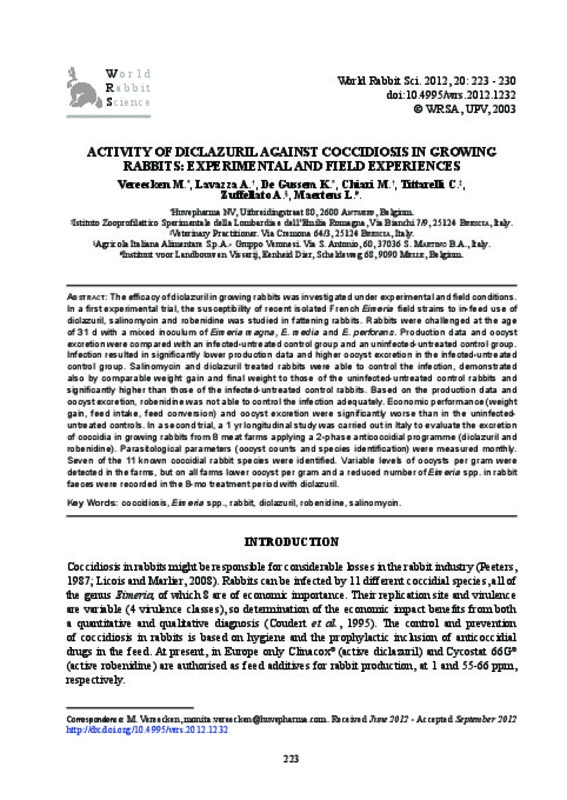JavaScript is disabled for your browser. Some features of this site may not work without it.
Buscar en RiuNet
Listar
Mi cuenta
Estadísticas
Ayuda RiuNet
Admin. UPV
Activity of diclazuril against coccidiosis in growing rabbits: experimental and field experiences
Mostrar el registro sencillo del ítem
Ficheros en el ítem
| dc.contributor.author | Vereecken, Monita
|
es_ES |
| dc.contributor.author | Lavazza, A.
|
es_ES |
| dc.contributor.author | De Gussem, K.
|
es_ES |
| dc.contributor.author | Chiari, M.
|
es_ES |
| dc.contributor.author | Tittarelli, C.
|
es_ES |
| dc.contributor.author | Zuffellato, A.
|
es_ES |
| dc.contributor.author | Maertens, Luc
|
es_ES |
| dc.date.accessioned | 2013-01-09T11:45:34Z | |
| dc.date.issued | 2012-12-28 | |
| dc.identifier.issn | 1257-5011 | |
| dc.identifier.uri | http://hdl.handle.net/10251/18348 | |
| dc.description.abstract | [EN] The efficacy of diclazuril in growing rabbits was investigated under experimental and field conditions. In a first experimental trial, the susceptibility of recent isolated French Eimeria field strains to in-feed use of diclazuril, salinomycin and robenidine was studied in fattening rabbits. Rabbits were challenged at the age of 31 d with a mixed inoculum of Eimeria magna, E. media and E. perforans. Production data and oocyst excretion were compared with an infected-untreated control group and an uninfected-untreated control group. Infection resulted in significantly lower production data and higher oocyst excretion in the infected-untreated control group. Salinomycin and diclazuril treated rabbits were able to control the infection, demonstrated also by comparable weight gain and final weight to those of the uninfected-untreated control rabbits and significantly higher than those of the infected-untreated control rabbits. Based on the production data and oocyst excretion, robenidine was not able to control the infection adequately. Economic performance (weight gain, feed intake, feed conversion) and oocyst excretion were significantly worse than in the uninfected-untreated controls. In a second trial, a 1 yr longitudinal study was carried out in Italy to evaluate the excretion of coccidia in growing rabbits from 8 meat farms applying a 2-phase anticoccidial programme (diclazuril and robenidine). Parasitological parameters (oocyst counts and species identification) were measured monthly. Seven of the 11 known coccidial rabbit species were identified. Variable levels of oocysts per gram were detected in the farms, but on all farms lower oocyst per gram and a reduced number of Eimeria spp. in rabbit faeces were recorded in the 8-mo treatment period with diclazuril. | es_ES |
| dc.language | Inglés | es_ES |
| dc.publisher | Editorial Universitat Politècnica de València | es_ES |
| dc.relation.ispartof | World Rabbit Science | |
| dc.rights | Reserva de todos los derechos | es_ES |
| dc.subject | Coccidiosis | es_ES |
| dc.subject | Eimeria spp | es_ES |
| dc.subject | Rabbit | es_ES |
| dc.subject | Robenidine | es_ES |
| dc.subject | Diclazuril | es_ES |
| dc.subject | Salinomycin | es_ES |
| dc.title | Activity of diclazuril against coccidiosis in growing rabbits: experimental and field experiences | es_ES |
| dc.type | Artículo | es_ES |
| dc.date.updated | 2013-01-09T11:03:04Z | |
| dc.identifier.doi | 10.4995/wrs.2012.1232 | |
| dc.rights.accessRights | Abierto | es_ES |
| dc.description.bibliographicCitation | Vereecken, M.; Lavazza, A.; De Gussem, K.; Chiari, M.; Tittarelli, C.; Zuffellato, A.; Maertens, L. (2012). Activity of diclazuril against coccidiosis in growing rabbits: experimental and field experiences. World Rabbit Science. 20(4):223-230. https://doi.org/10.4995/wrs.2012.1232 | es_ES |
| dc.description.accrualMethod | SWORD | es_ES |
| dc.relation.publisherversion | https://doi.org/10.4995/wrs.2012.1232 | |
| dc.description.upvformatpinicio | 223 | |
| dc.description.upvformatpfin | 230 | |
| dc.description.volume | 20 | |
| dc.description.issue | 4 | |
| dc.identifier.eissn | 1989-8886 |








